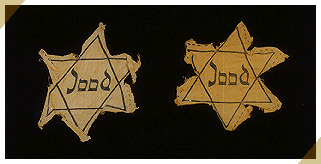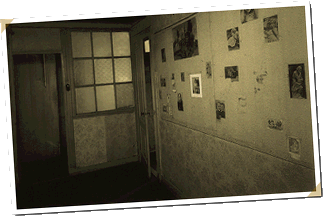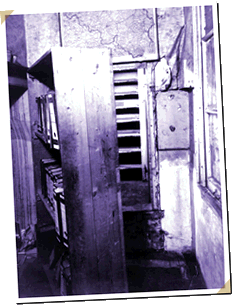The Life of Anne Frank
|
Share This Page
|
|
|
|
|
|
|
Follow This Site

|
 |
|
|
Part 2: Occupation and Hiding
It was in 1940 that Germany occupied the Netherlands. The occupying Germans brought with them the same sort of treatment of Jewish people that they had been doing in their home country. Anti-Jewish decrees began in the Netherlands soon after the occupation. Anne suddenly found herself unable to attend the local Montesori school that she had been attending, simply because she was Jewish. Her last year there was 1941. In 1942 came the first law requiring Jewish men and women to report to Westerbork, a "work camp." If the men and women didn't go, they were sent to prison.
 It was also in 1942 that Jewish people living in the Netherlands were required to wear a yellow Star of David on their clothes, so that everyone would know that they were Jewish.
It was also in 1942 that Jewish people living in the Netherlands were required to wear a yellow Star of David on their clothes, so that everyone would know that they were Jewish.
Jewish people at that time had few choices for safety. One was to try to escape. Germany controlled increasing amounts of territory in Europe, however, and Jewish people would have faced the same sort of treatment in any German-occupied territory that they could expect at home. Another option was to hide, hoping that the Germans would eventually go away. This is what the Franks did.
On July 6, 1942, the Franks began hiding. Margot, Anne's sister, was 16 and had received a notice to report to a labor camp the day before. They quickly packed a few of their belongings and went into hiding, in a few rooms right above Otto Frank's business. Along with another Jewish family, the van Pelses (Herman; his wife, Auguste; and their son, Peter), and a man named Fritz Pfeffer, the Franks hid for more than two years before being discovered.
Victor Kugler and Johannes Kleiman, who now ran Otto Frank's business, agreed to help hide the Franks and the Van Pelses. Also helping make sure that the Jewish people weren't discovered were Jan and Miep Gies, Bep Voskuijl, and Bep's father. The business kept running, as if nothing were out of place. The "helpers" secretly brought the "hiders" food and information. The Franks, von Pelses, and Fritz Pfeffer were hiding upstairs and had to be quiet at all times, for fear of making a noise that would reveal their hiding place, not only to the German soldiers who made regular searches of the business but also to the people who worked there who might not be entirely sympathetic to the plight of Jews.
 For young Anne, who was 13 when the hiding began, the hiding place was much too small. (Eight people were hiding there, in a space not exactly designed to hold that many people.) Her bedroom was small and narrow. On the wall, she put posters and postcards of movie stars. She missed her cat, Moortje. She wanted to see the world. Her parents managed to convince her to stay put, however, and she wrote of much of what she wished she could see in her now-famous diary, which she received as a birthday gift when she turned 13. She called the diary "Kitty" and wrote in it faithfully for the remainder of her time in Amsterdam.
For young Anne, who was 13 when the hiding began, the hiding place was much too small. (Eight people were hiding there, in a space not exactly designed to hold that many people.) Her bedroom was small and narrow. On the wall, she put posters and postcards of movie stars. She missed her cat, Moortje. She wanted to see the world. Her parents managed to convince her to stay put, however, and she wrote of much of what she wished she could see in her now-famous diary, which she received as a birthday gift when she turned 13. She called the diary "Kitty" and wrote in it faithfully for the remainder of her time in Amsterdam.
 The hiding place was called the Secret Annex. It remained secret until August 4, 1944, when the Security Police found it, acting on a tip from a Dutch informant. A hinged bookcase at the rear of one wall of the office hid the entrance to the Secret Annex. When the German police arrived, they marched straight for the bookcase and opened it, a sign that they had received a tip from someone who knew where the Jews were hiding. The Frank family and others who were hiding there were arrested and sent eventually to Auschwitz, a concentration camp that had a reputation for killing many of the people who were sent there. Meanwhile, Victor Kugler and Johannes Kleiman, who took over the business when Otto Frank and Herman van Pels went into hiding, were arrested when it was discovered that they helped hide the families. The police took Miep Gies for questioning but did not arrest her.
The hiding place was called the Secret Annex. It remained secret until August 4, 1944, when the Security Police found it, acting on a tip from a Dutch informant. A hinged bookcase at the rear of one wall of the office hid the entrance to the Secret Annex. When the German police arrived, they marched straight for the bookcase and opened it, a sign that they had received a tip from someone who knew where the Jews were hiding. The Frank family and others who were hiding there were arrested and sent eventually to Auschwitz, a concentration camp that had a reputation for killing many of the people who were sent there. Meanwhile, Victor Kugler and Johannes Kleiman, who took over the business when Otto Frank and Herman van Pels went into hiding, were arrested when it was discovered that they helped hide the families. The police took Miep Gies for questioning but did not arrest her.
Next page > A Sad End > Page 1, 2, 3